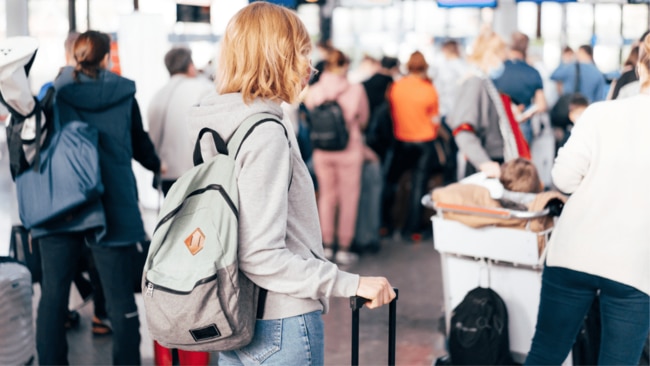This is the key to beating jet lag if you're heading away
Take back your body clock
If you’re planning a sunny European getaway this year, the last thing you want to be worrying about is not getting enough shut-eye. Here’s how an expert recommends hacking your way through jet lag for an upcoming trip.
By now, we’re well attuned to the benefits of noise and light when it comes to inducing rest. There are endless playlists, sound machines and white noise sources designed to relax the mind and body, with specialised lamps, lights, screen settings and glasses available to counteract the influence of our modern habits and technology.
Still, according to a survey conducted late last year, 4 in 5 Aussies are struggling to drift off into a quality slumber at night, with nearly half of us not getting enough sleep full stop. But what happens when you throw your schedule off completely with a 14-hour flight to Athens?
Sure, getting enough sleep may be simple enough when you’re in the comfort of your own bed and routine, but travelling through a vastly different timezone is bound to throw anyone’s body clock out of whack.
According to the Mayo Clinic, jet lag is categorised as a temporary sleep disorder that occurs as a result of travelling between time zones too quickly (such as on an Airbus A380 moving at 1,185 km per hour). While the symptoms of jet lag mostly consist of fatigue and trouble sleeping, it can be incredibly inconvenient both at the beginning of a long-awaited vacation, and when the demands of work and routine hit upon your return.
As sleep scientist Dean Miller explains to the Australian Financial Review, to understand why our bodies succumb to jetlag, we must first understand how our internal body clocks operate.
“Basically, we have this point in our body clocks, let’s call it the start of our body clock, and it usually falls between midnight and 4 AM,” says Miller, who is enlisted to assist Australia’s Olympic athletes overcome their dreaded jet lag ahead of the Games next month. “If you get light within three or so hours before that time, it’s going to move your body clock later in the day. And if you get light after that time, it’s going to move your body clock earlier in the day.”
As part of his role, Miller will instruct the athletes – based on factors such as their core body temperature rhythm, sleep habits, and incoming flight route – when to seek and avoid daylight.
So, if you’re heading to Europe in the next few months (and let’s face it, who isn't?) you may want to take some notes.

How to avoid jet lag when flying to Europe
When flying west, such as from Sydney to Paris, it’s recommended we shift our body clock later in the day in preparation for our destination’s timezone. Miller explains he’d instruct a person to maximise their sunlight exposure and other forms of bright light in anticipation, but what time is ideal?
Giving an example, Miller says if someone (who usually sleeps at 10 PM) is flying to Paris, they should aim to maximise their natural and bright light exposure between 1 PM and 7 PM, then specifically try to avoid it.
As Paris (and the rest of Europe) is in the middle of their sunniest season, sunset can be as late as 10 PM some nights, meaning sticking to this recommendation is trickier than it may seem.
“The neat thing is you can go to sleep after 7 PM if you want to because that means you’re still avoiding light during that time,” says Miller. As much as this makes sense, a 7 PM bedtime during Euro summer isn’t exactly going to fly with most people’s itineraries. Instead, Miller advises people to simply “Go indoors and keep the lights nice and dim” during their first few days overseas to help offset any jet lag.
Upon returning to Australia, Miller says it’s helpful to seek sunlight exposure between 5 AM and 11 AM back home after touching down and avoiding bright light from 11 AM onwards.
“It sounds relatively simple, but it can get tricky when you start dealing with timezone changes, flight routes and time of arrival because sometimes your arrival is after the optimal seek-light period, which means you have to push it to the next day,” Miller says.

Jet lag dos and don’ts when travelling
Yu Sun Bin, an epidemiologist and public health researcher at the University of Sydney, says anything that alleviates your general stress of travelling is worth investing in for long-haul flights, such as wearing a comfy outfit, staying hydrated, finding opportunities to walk up the plane aisle and stretch, and investing in a pair of noise-cancelling headphones.
“When you’re flying, you’re exposed to the noise of the flight, the acceleration, the vibrations, and all those things contribute to that sense of fatigue, tiredness and feeling overwhelmed,” Bin tells the AFR.
As a general precaution, Miller and Bin both rarely endorse pharmacological intervention to overcome or preempt jet lag, preferring to focus on adjusting the body’s internal clock with the tools at hand.
In addition to Bin’s flying tips, Miller says it’s worth wearing medical-grade compression socks to aid circulation and a face mask to ward off viruses.
More Coverage
Originally published as This is the key to beating jet lag if you're heading away




